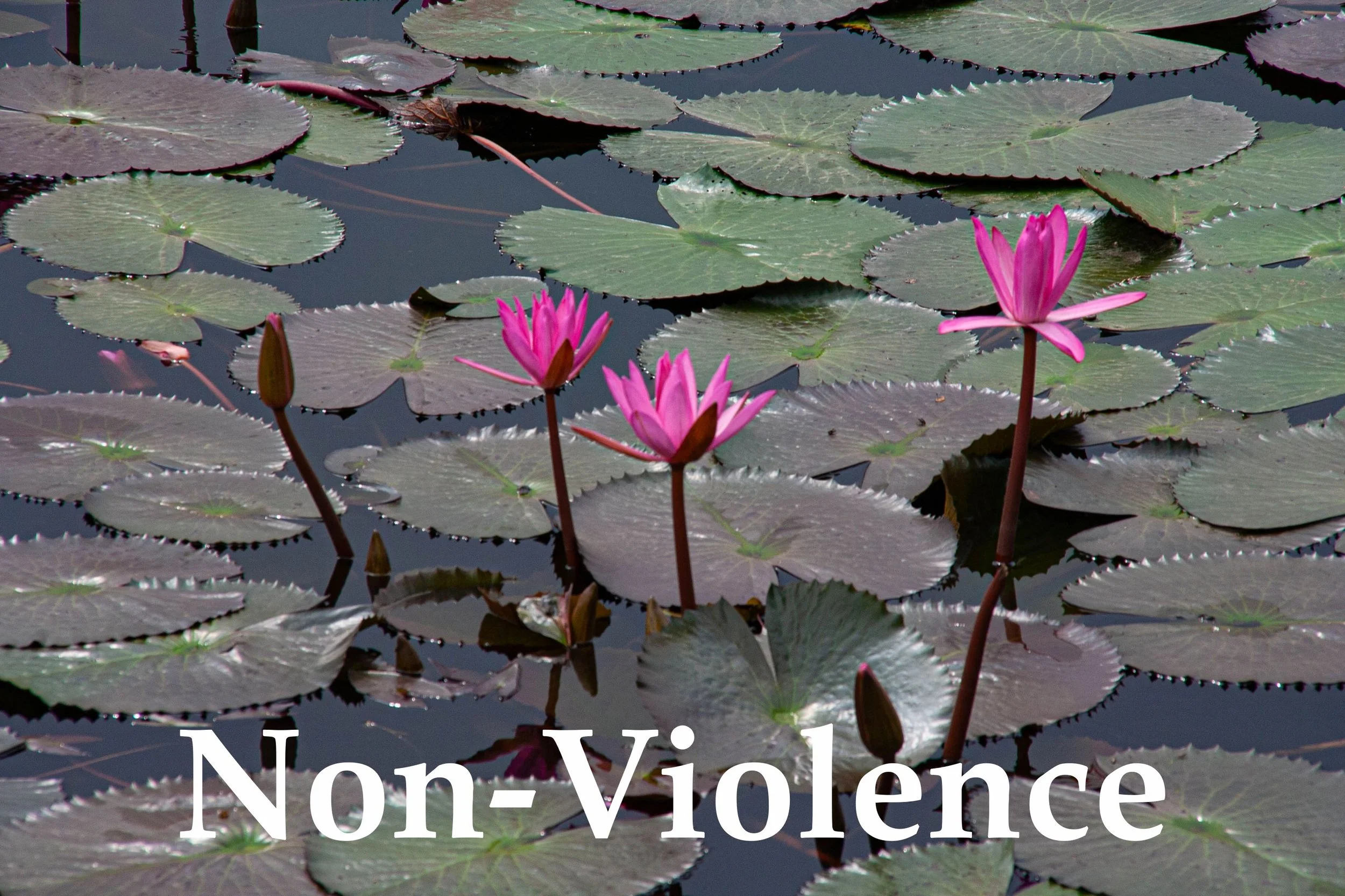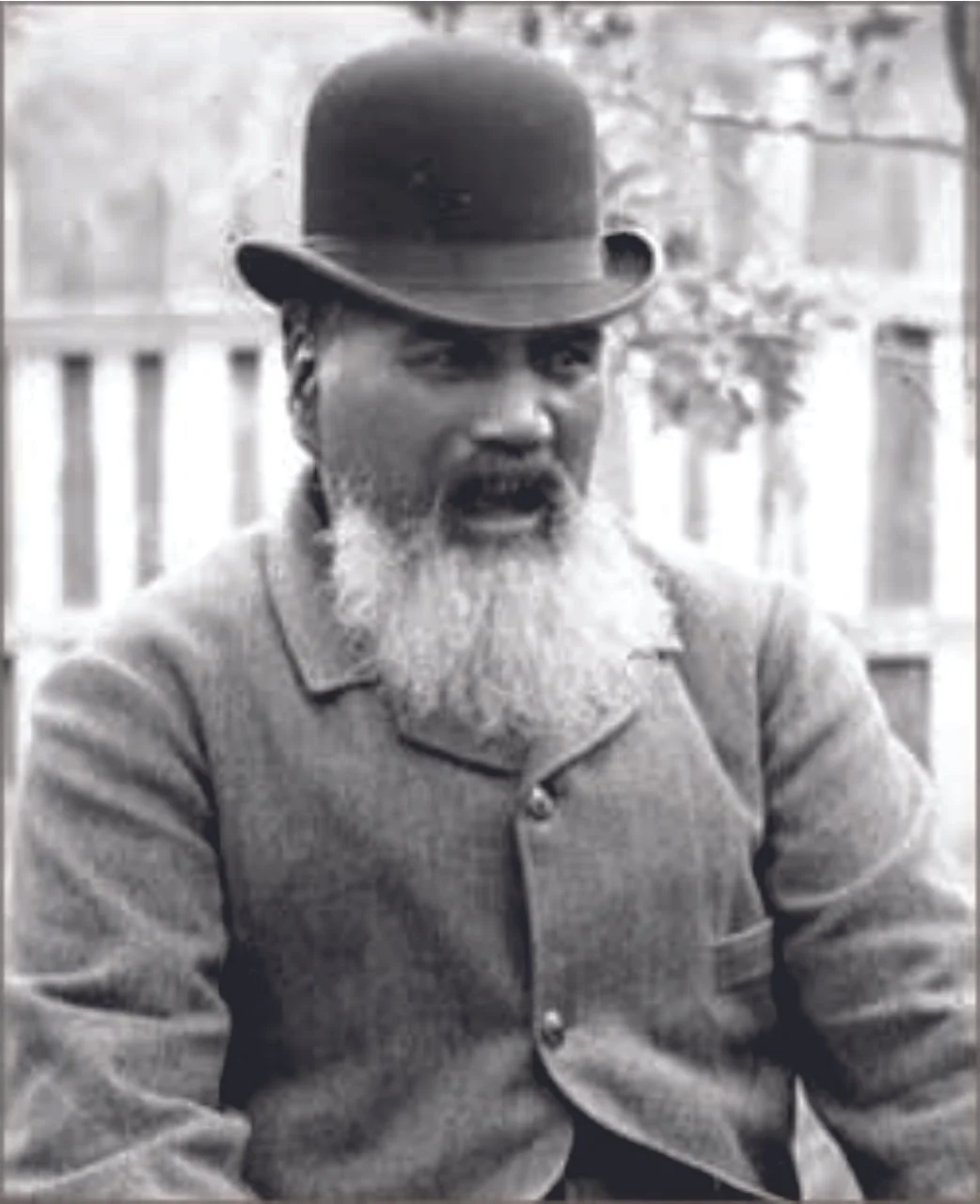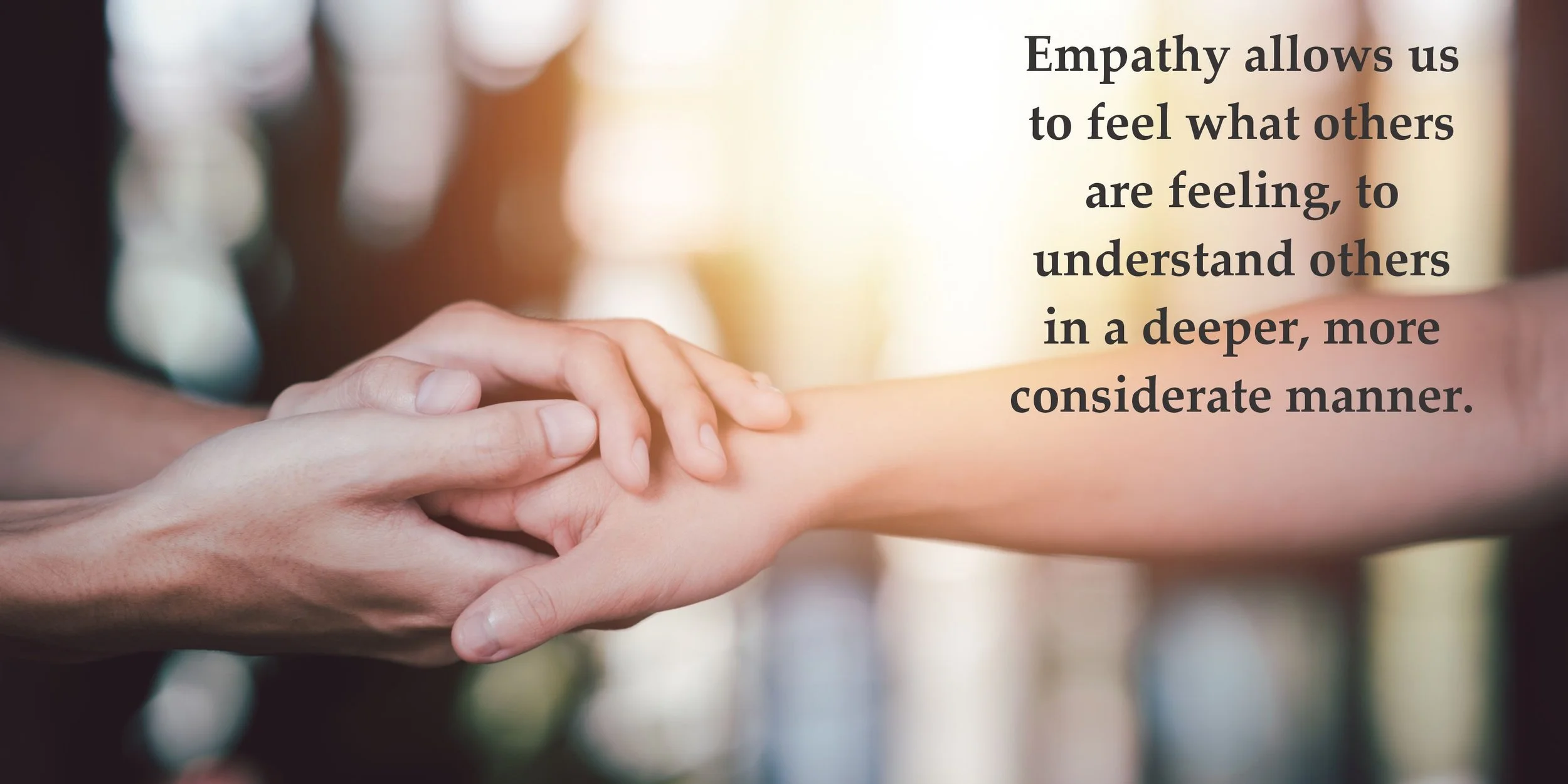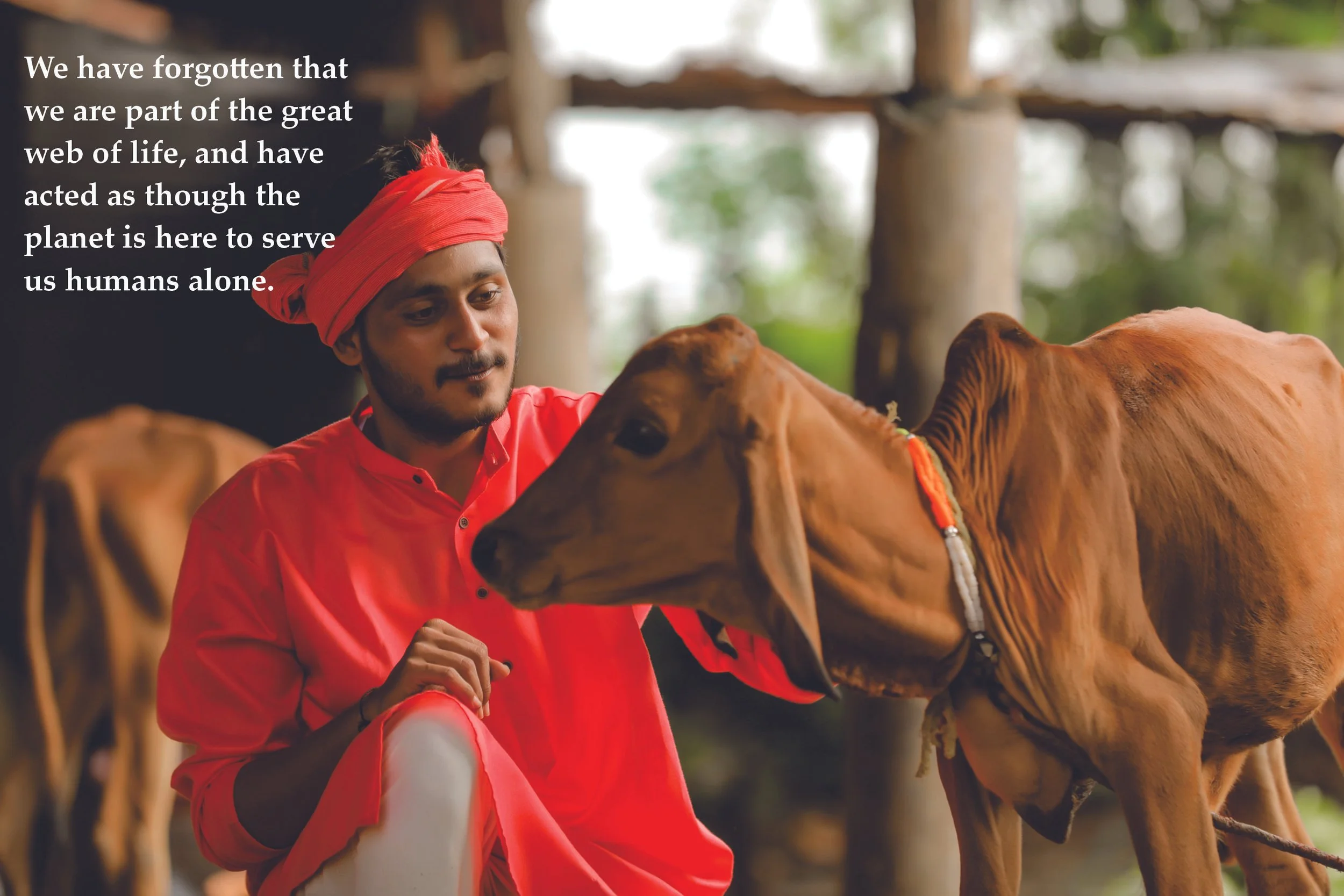PREMA JYOTHI Newsletter of the Prema Trust and Sacred Earth Community – October 2025
Kia Ora Koutou. The third of our Human Values Series sees us explore a value that is intensely current. Violence has permeated every level and every activity in our global society, from our ‘entertainment’ to our schools and young people, in our politics and in our interpersonal relationships.
When we think of violence, we generally consider physical violence. But violence does not even begin with the physical, it begins in a mind that is often full of confusion, doubt and a sense of separateness. Violence begins with a thought, an idea in the mind. Why then should ahimsa (non-violence) not also arise from thought? It is important that when we tackle the subject of violence/non-violence we begin with looking at the root causes, the role of the mind and especially the conditioned mind, in birthing either one of these two opposite trends or forces that are highly operative in dramatically affecting our lives today.
Where does Violence Begin?
It is important to phrase this question as ‘where?’ and not ‘how?’ Violence arises from a place deep within. It is a place of separation from the awareness of the oneness that is the base reality of our universe. The sense of separation often causes desperation, where people are vulnerable to taking a route that ends in violence, either because they are encouraged to do so by others who are also in the same place, or circumstances that convert the desperate separation experienced into a reaction that is violent.
It at this source that we need to start developing non-violent responses to life’s situations. When we think of violence, we often conjure images of physical harm, psychological harm, verbal harm or what might be called societal harm. Many solutions to the violence we find in our world are postulated. Very few are focused on the state of our inner life, the return to the heart. Just as violence is born of ignorance, non-violence is born from a Heart full of Love. Let us explore an examples.
Where does Violence Begin?
It is important to phrase this question as ‘where?’ and not ‘how?’ Violence arises from a place deep within. It is a place of separation from the awareness of the oneness that is the base reality of our universe. The sense of separation often causes desperation, where people are vulnerable to taking a route that ends in violence, either because they are encouraged to do so by others who are also in the same place, or circumstances that convert the desperate separation experienced into a reaction that is violent.
It at this source that we need to start developing non-violent responses to life’s situations. When we think of violence, we often conjure images of physical harm, psychological harm, verbal harm or what might be called societal harm. Many solutions to the violence we find in our world are postulated. Very few are focused on the state of our inner life, the return to the heart. Just as violence is born of ignorance, non-violence is born from a Heart full of Love. Let us explore an examples.
An Inspiration from Aotearoa/ New Zealand
Te Whiti
Tohu
In the past few centuries there have been people who stand out for their espousal and practice of non-violence. Mahatma Gandhi and Nelson Mandela are commonly cited. Two outstanding people who are not so well-known are Te Whiti o Rongomai and Tohu Kakahi (Te Atiawa) of the Taranaki Māori. Long before Gandhi was establishing his non-violent protests in South Africa, Te Whiti o Rongomai and his relative and companion Tohu Kakahi were using non-violent principles and practices in their fight for justice against the British colonists.
Prior to his campaign against the land seizures, Te Whiti was already known for saving the survivors of a shipwreck. These hapless pākeha were threatened by local Māori, but Te Whiti came and fed them and helped them back to New Plymouth.
After seeing the ruthless landgrab of the government of the day, Te Whiti and Tohu were disturbed and concerned to find a solution. The story goes that Te Whiti was travelling down the coast in a waka (canoe). When he came ashore, he travelled up the river to a place where he received a vision. It was then that he knew that he was to establish a settlement at this place. On coming back to consciousness, he danced (haka) and so the place was named pari (meaning abundance) and haka (dance).
Te Whiti and Tohu had seen the devastation of war when the colonial armies seized land north of New Plymouth (the Waitara block) and it must have moved his heart. Now, after his vision, he knew that violence was not the answer. He decided there had to be another way and so began a passive resistance movement in the Taranaki region, centred on Parihaka. This movement gathered followers from all over Aotearoa, from several other iwi (tribes) and even a few pakeha supporters. The people of Parihaka tore down fences and ploughed land that had been illegally claimed by the government, but they pledged to bear no arms and do no violence. This non-violent form of protest went against the tide of the times and was rooted in a deep spiritual belief that all life is sacred. It began a passive resistance movement that was powerful in its expression and rooted in the spirituality of Te Ao Māori (the Māori world).
The Government eventually moved against the village, coming in force. The people gathered in the centre in silent resistance, saying nothing but unmoved by the order of the colonial army to disperse. There is a beautiful tale of the standoff that has been handed down. Whilst the situation was tense and anything could have happened, a dog was seen climbing the small hill on which the colonial army was positioned. The dog went up to one of the cannons and urinated on the gunpowder rendering it useless for firing the gun. This caused some merriment among the people of Parihaka and was a sign that their principle of non-violence would prevail and not be compromised by the presence of the army.
So it happened. The army moved arresting Te Whiti and Tohu and most of the male followers, burning houses, raping the women and killing several. But still the people held their highest belief in their cause and their spiritual faith and there was no resistance.
The Men were taken to Te Wai Pounamu (the South Island) and imprisoned under very harsh circumstances. The women were left, their bodies defiled, but their mana (pride and integrity) untouched.
It was over a century later that the New Zealand Government gave redress to the people of Parihaka, along with an apology. But the spirit of Te Whiti and Tohu lives on in the memory of those times. I was privileged to attend the 100th anniversary of the invasion and to work alongside the elders of the marae, in harmony and loving discourse. It is a memory I cherish. Ahau whakahere whakaute e whakawhetai ko Te Whiti O Rongomai raua Tohu Kakahi (I offer respects and gratitude to Te Whiti and Tohu) for their wonderful inspiration of the power of whakamarietanga – peaceful non-violence.
Taranaki Maunga and Te Awa Hangatahua (Stoney River) near Parihaka
On a personal note, one of my ancestors (Great Great Grandfather) was in the Taranaki militia (not at Parihaka). In some ways I feel that my love for Te Whiti and Tohu (lofty mountains indeed) goes a small way to redeeming our family’s involvement in the Taranaki wars and the Parihaka episode that followed.
Approaches and Aspects of Non-Violence
Compassion and Empathy
We cannot simply forgo violence by ceasing to act. We must develop character related values that foster a life without violence. The above graphic depicts a few of these values with the most important being compassion and empathy, as these directly forestall the very thought of harming others.
Compassion can be thought of as common passion meaning that we feel what other are feeling. When we speak or act harshly, if we have compassion, we experience the pain that others feel. Then we can reverse the damage caused. That redeeming of the situation is non-violence. Often, we cause pain unknowingly, unintentionally, but we can resolve the situation by apologising or making good the hurt we have inflicted. Better, is to pause prior to speaking or acting, and consider the effect of our words or actions on another (be it another person, creature or the environment). That pause will allow us to not only avoid pain to others, but also takes us deeper into our own hearts, allowing us to develop spiritually as we move into the purity of who we really are – not the person who inflicts harm, but a person who cares for all.
Empathy allows us to feel what others are feeling, to understand others in a deeper, more considerate manner. As such, it is the natural companion of compassion. Without some empathy, we are unable to have compassion. Without compassion, empathy has no deep effect on our spiritual lives. The opposite of compassion and empathy is indifference, which hardens the heart and is nearly as bad as harming others.
Compassion and empathy are acquisitions that not only support non-violence towards others but actively allow the heart to open to the possibility of Love. The one person we all need to have compassion and empathy for is ourselves. Commonly, violence towards others is a product of a lack of self-love. The extreme result of this is self-harm and/or suicide. But there are many intermediary steps that lead us from berating ourselves because we have made mistakes (“you stupid person”, “why did you do such a dumb thing?”) to being so distressed that we would do harm to ourselves. I speak from my own experience as to how devastating and debilitating this type of attitude to ourselves can be. In my case, it has led to, at times in the past, deep depression. Sai is teaching me that I am worthy – a difficult project, but a worthy one. As we grow spiritually, compassion for mistakes we have made converts thoughts of harm into self-acceptance, a progression towards true self-love.
Forgiveness
A powerful tool for the transformation of violence into non-violence, forgiveness is an often-overlooked step in the support of the creation of understanding. We hear and see so many horror stories about what is happening in Gaza. Yet, behind all the headlines of destruction and killing there is at least one heartening effort being made to create peace, using the power of forgiveness. Ex-soldiers from the Israeli army and the Palestinian militia have come together to form Combatants for Peace. A documentary about this group was issued in 2025, which “challenges viewers to engage in a crucial, humane conversation — one that recognizes shared humanity and seeks a compassionate, pragmatic path toward peace, dignity, and self-respect”. This film is called There is Another Way and it shows the role of forgiveness in creating peace between communities in that troubled area of the world.
In South Africa, the Truth and Reconciliation Committee prevented major violence and revenge seeking after the dissolution of apartheid. In Rwanda, there are stories of how forgiveness prevented tit for tat killings between major tribal groups after the civil war. In Rwanda lies a small village that is a living example of the practice of forgiveness. The Rweru Reconciliation Village houses survivors of the genocide that occurred in the nineties, and perpetrators of that genocide. These people have chosen to live side by side, a shining example of the power of forgiveness.
In our lives, we all need to learn to forgive, the small things and the big issues. Each act of forgiveness contributes to strengthening our spiritual unity.
Inclusiveness
Much of the world’s violence is against the ‘other’. ‘Othering’ as it is termed is the creating of separation between communities, as well as individuals. It can occur across large groups (based on ethnicity usually), but also in smaller communities, such as school bullying. When we begin to see the people of the world as one family, when we begin to know and understand each other, we begin to break down the barriers that lead to violence. Sai says, “First understanding, then adjustment”. One of the ways in which we can understand each other is through hearing each other’s stories. Story telling is a powerful way of fostering non-violence. It creates emotional connections and empathy, whilst building the identities of communities and sharing those identities with other communities. The power of storytelling can allow for greater communication as well as allowing activities that foster participation in activities between communities. Much of the conflict between people comes from not knowing the story of the other person. It is easy to jump to conclusions about individuals and communities when we don’t know what has led to any situation or behaviour.
The development of a culture of storytelling is sadly lacking in our modern society. We don’t often have (or take) the time to listen to other’s stories. Communities are built on this very basis, and the power of storytelling in fostering non-violence is often underestimated
Companionship
Begins when we share our stories, when we get to know the other person. It is a facet of inclusiveness that creates a very personal approach to understanding. Our companions are our friends who support us when we face difficulties, as well share good and bad times together. As our sense of companionship grows, we come to realise that the circle of companions grows. Communication becomes based on understanding and understanding leads to adjustment, which lessens the chance of friction between us and others.Sadly lacking in modern society, kindness is an essential ingredient for the successful functioning of any community of people. I was so heartened when our government attempted to foster a nation of kindness some years ago. I am saddened to see that this has been reversed in favour of a focus on material prosperity for some, no matter what the cost to people and the environment.
There is a beautiful concept called random acts of kindness where people give away things to total strangers. It has morphed into a ‘Random Acts of Kindness Day in New Zealand. It has the potential to bring communities together, sowing happiness. Kindness is really the positive opposite of violence. Rather than just desisting from being mean or cruel to others, we actually create positivity within communities.
Kindness
Sadly lacking in modern society, kindness is an essential ingredient for the successful functioning of any community of people. I was so heartened when our government attempted to foster a nation of kindness some years ago. I am saddened to see that this has been reversed in favour of a focus on material prosperity for some, no matter what the cost to people and the environment.
There is a beautiful concept called random acts of kindness where people give away things to total strangers. It has morphed into a ‘Random Acts of Kindness Day in New Zealand. It has the potential to bring communities together, sowing happiness. Kindness is really the positive opposite of violence. Rather than just desisting from being mean or cruel to others, we actually create positivity within communities.
Concern for all Life
Life is sacred. Life is the expression of the Divine on this planet. Life is to be cherished. We only have to watch the incredible nature programmes that regularly appear on TV and film to see the way that all life on this planet is intricately entwined together. But we see these programmes, yet humanity is complicit in the destruction of this great web of life across this planet in so many ways. We have forgotten that we are part of the great web of life and have acted as though the planet is here to serve us humans alone.
The phenomenon of climate change, the pollution of the land and oceans, the manipulation of species (genetic and otherwise) and the farming practices are all acts of violence against Papatuanuku (Mother Earth – Gaia). Most people are aware of what is happening (at least some of what is happening) but our habitual reliance on comfort and convenience renders change nearly impossible unless we wake up BIG TIME.
One approach that needs more open discussion is not killing animals for food. I realise that for many, especially indigenous peoples, this has been part of their way of life. However, the methods and approaches, particularly a spiritual approach to the hunting and using animals for food, is not how most food from the killing of animals is obtained nowadays. The farming of animals to feed people is no longer sustainable. Not only does it harm the animal and, in many cases the species (in terms of them no longer being able to live as nature intended them to live) but it does immense harm to the environment and the planet as a whole. The lack of ethics in such practices have become unjustifiable. Sacred Earth has been established on vegetarian principles and we are encouraging all who live here or are associated with Sacred Earth to adopt a conscious vegetarian diet
Non-Violence a positive force
Non-violence can be understood to be a force for changing the course of history. The example of what happened at Parihaka, whilst it did not immediately bring about change, has led to a now thriving marae under the Taranaki Maunga (Mt Taranaki), where all peoples are welcomed in peace. The story of Parihaka, long suppressed in the teaching of the history of Aotearoa in schools, has now emerged from a ‘cloud of unknowing’ to be a part of the Aoteroa New Zealand Histories curriculum. There is still much to be done to reverse the centuries of distrust and resentment, but there are those who believe in the principle of non-violence and are working to create understanding between all the peoples of Aotearoa.











